- Home
- The Autumn Garden
- Autumn Leaf Color Trees
The Best Trees for Autumn Leaf Color Are Some of the Most Beautiful You
Can Choose for All Seasons
The glory of autumn leaf color in autumn is something I took forward to every year. I always try to incorporate trees into my landscape that will reward me with the most vibrant color. Not all of your trees have to turn brilliant colors, but a few strategically placed will add beauty to your property and give you pleasure every year. And it is easy to do because many of the best trees for autumn color are top performers in all seasons. Many factors contribute to the brilliance of fall color such as location, temperatures, soils and moisture, and the display can change from year to year. Some species color more vividly in some parts of the country than others. We all know about the spectacular colors of a New England autumn!
"A civilization flourishes when people plant trees under whose shade they will never sit." Greek saying
Here are some of the best trees for autumn leaf color.
Maples for Autumn Leaf Color
Acer griseum, paperbark maple, Zones 5-7. Paperbark maple is an outstanding tree for autumn leaf color. The leaves turn a brilliant crimson, and as a bonus, the exfoliating cinnamon bark is very handsome, too. An excellent choice for the home landscape.
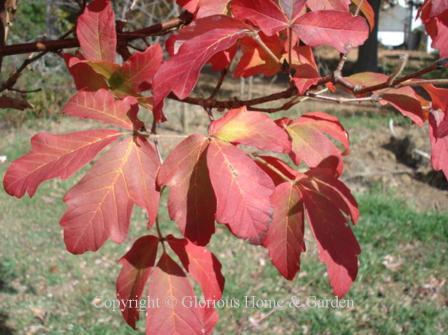 Acer griseum
Acer griseumAcer japonicum, fullmoon maple, Zones 5-7. Beautiful coloration of yellow, red and orange occur on this species of Japanese maple. The leaves of most cultivars are not as deeply incised as Acer palmatum giving them a rounded, or "full moon" effect.
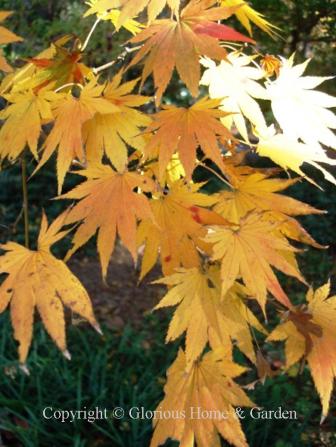 Acer japonicum
Acer japonicumAcer japonicum 'Aconitifolium,' fernleaf maple, Zones 5-7. Fernleaf Japanese maple is one of the exceptions to the rule for Acer japonicum in that its leaves are deeply divided and incised and, well, "ferny." Turns a brilliant crimson in the fall.
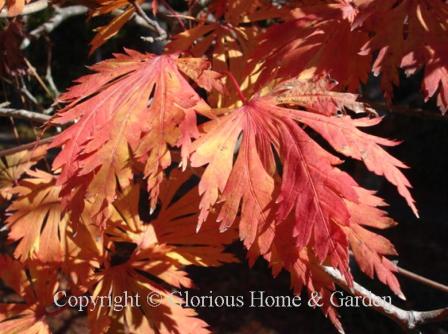 Acer japonicum 'Aconitiolium'
Acer japonicum 'Aconitiolium'Acer palmatum, Japanese maple, Zones 5-8. Japanese maples are the loveliest and most graceful of garden trees. They vary greatly in size, form and leaf-shape. Fall color depends on the cultivar. There are two main categories: non-dissected and dissected leaf types. The non-dissected group is represented by the red 'Bloodgood' below with finger-like lobed leaves. The dissected types are represented below by Acer palmatum var. dissectum 'Viridis' with finely cut leaves that turn a lovely yellow in fall. Visit local nurseries and public gardens to see cultivars to help your selection, but do try to incorporate at least one Japanese maple in your landscape in a place of honor.
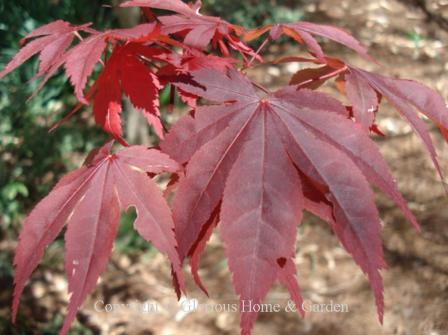 Acer palmatum 'Bloodgood'
Acer palmatum 'Bloodgood'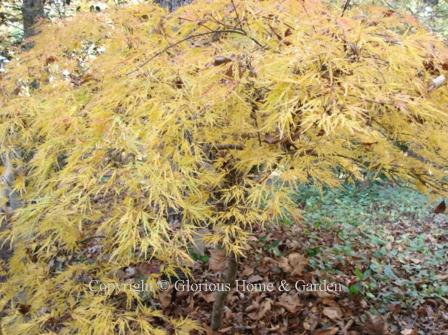 Acer palmatum var. dissectum 'Viridis'
Acer palmatum var. dissectum 'Viridis'Acer palmatum 'Dissectum,' threadleaf Japanese maple, Zones 5-8. I recently saw this gorgeous specimen at the Morris Arboretum and had to include it here. The coloration of the finely cut foliage was remarkable--a rainbow of green, yellow, orange, red and purple all exhibited together in a spectacular display! Threadleaf Japanese maple grows in a rounded mound of about 6-10' tall with equal spread.
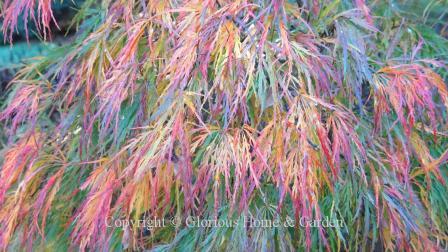 Acer palmatum 'Dissectum'
Acer palmatum 'Dissectum'Acer pseudosieboldianum, purplebloom or Korean maple, Zones 4-7. I have put this maple on my must-add-to-my-garden list after seeing some magnificent specimens recently at the Morris Arboretum! They were at the peak of autumn color in shades of orange to red to purple. Gorgeous!
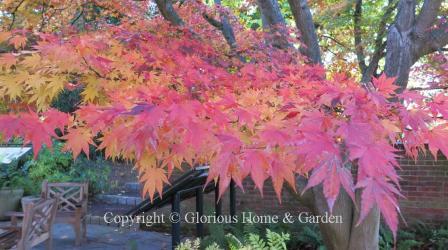 Acer pseudosieboldianum
Acer pseudosieboldianumAcer rubrum, red maple, Zones 4-9. Our native red maples are quite variable as to autumn leaf color but certainly many are spectacular in the wild. To ensure brilliant orange to red color, choose a named cultivar such as 'Brandywine,' 'October Glory' or 'Red Sunset.' 'October Glory' is pictured.
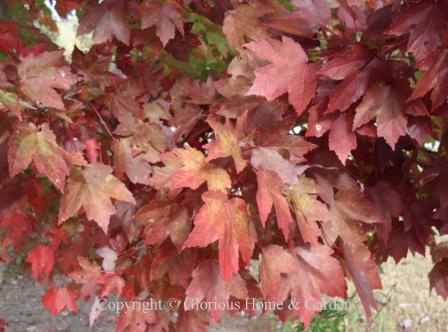 Acer rubrum
Acer rubrumAcer saccharum, sugar maple, Zones 4-8. The sugar maple is one of our most magnificent native trees. The best color show occurs in New England where trees turn yellow to orange and red and are synonymous with autumn. Is there a more breathtaking sight than a sugar maple in full autumn splendor? They can color quite well in the South also, and new cultivars selected for greater heat tolerance as well as autumn leaf color will make them more widely used there.
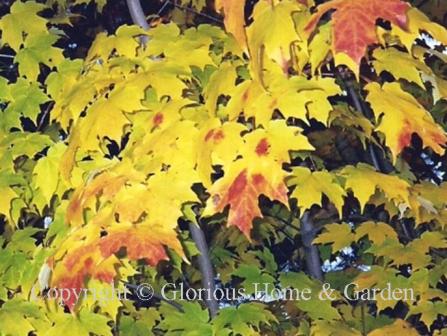 Acer saccharum
Acer saccharumAmelanchier arborea, serviceberry, Zones 4-9. A smallish native tree that produces white flowers in spring followed by delicious edible fruits which birds love, serviceberry can also produce outstanding autumn leaf color in shades of yellow to orange to red. Selections are being made for ornamental uses and outstanding fall color such as 'Autumn Brilliance,' and 'Princess Diana.'
Carya glabra, pignut hickory, Zones 4-9. A standout in autumn woodlands with deep golden-yellow leaf coloration.
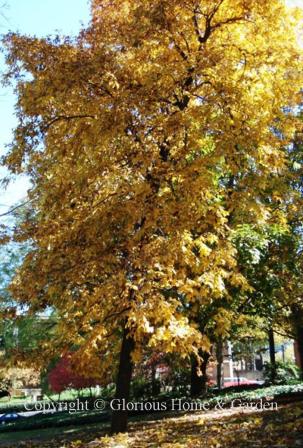 Carya glabra
Carya glabraCarya ovata, shagbark hickory, Zones 4-8. This young shagbark hickory exhibits the golden yellow to bronzy autumn leaf color common to the hickories that make them such standouts in the autumn woodlands. This will eventually be a huge tree of 60-80' or more so is best suited to a large property or woodland.
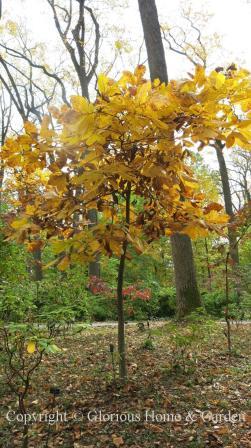 Carya ovata
Carya ovataCercidiphyllum japonicum, katsuratree, Zones 4-8. This is simply one of the most graceful and lovely trees one can grow. Autumn color varies from soft red to apricot-orange to yellow on rounded heart-shaped leaves similar to redbud leaves.
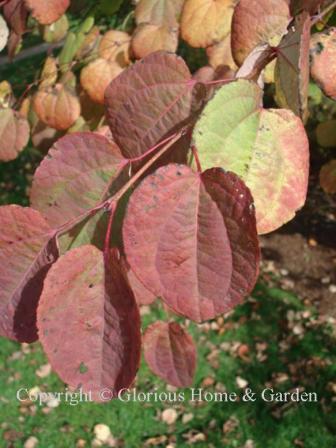 Cercidiphyllum japonicum
Cercidiphyllum japonicumDogwoods for Autumn Leaf Color
Cornus florida, flowering dogwood, Zones 5-9. Our native flowering dogwood produces its autumn leaf color in shades of pinkish-red to deep purple-red early in the fall and lasts a long time--usually up to Thanksgiving in the South. Red berries occur along with the fall foliage but are often stripped by birds.
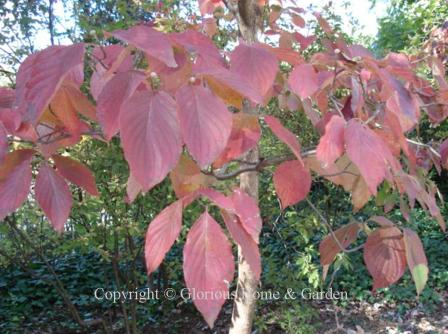 Cornus florida
Cornus floridaCornus kousa, Kousa dogwood, Zones 5-8. This Asian species turns scarlet red to purplish-red in fall, and the color persists for a long time.
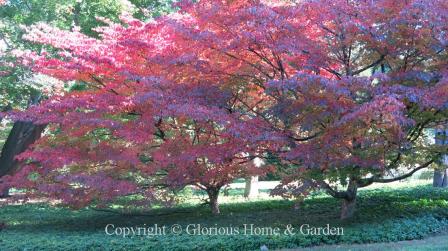 Cornus kousa
Cornus kousaFranklinia alatamaha, franklinia, Zones 5-8. Franklinia is a lovely small native tree that has the distinction of flowering in the late summer to early fall. Autumn leaf color ranges from orange to red and purple. An excellent small specimen tree.
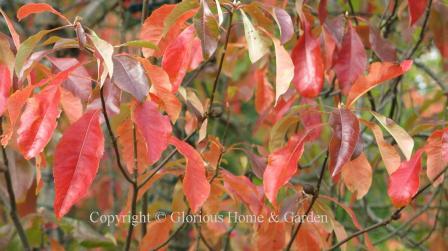 Franklinia alatamaha
Franklinia alatamahaGinkgo biloba, ginkgo, Zones 4-8. One of the most glorious trees in the fall when they turn brilliant clear yellow and then carpet the ground in gold. Can be truly spectacular. This one at the Arnold Arboretum in Boston.
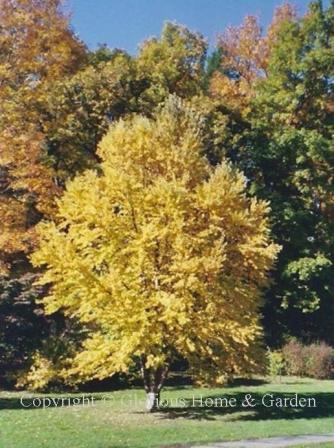 Ginkgo biloba
Ginkgo bilobaLagerstroemia indica, crape myrtle, Zones 7-9. Crape myrtles, used extensively in the South, can be a shrub or small tree depending on the cultivar and whether or not they are severely pruned in late winter as is the common practice, or allowed to grow to their full height. The leaves usually turn brilliant shades of yellow, orange, red and even purple in the fall; the dried seed capsules persist through winter. Prune these off in late winter before new growth begins.
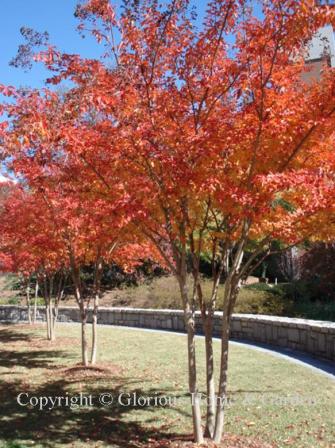 Lagerstroemia indica
Lagerstroemia indicaLiquidambar styraciflua, American sweetgum, Zones 5-9. A distinctive native tree of the Eastern U.S. woodlands, the star-shaped leaves of sweetgums will often exhibit a kaleidoscope of green, yellow, orange, red and purple autumn color at the same time.
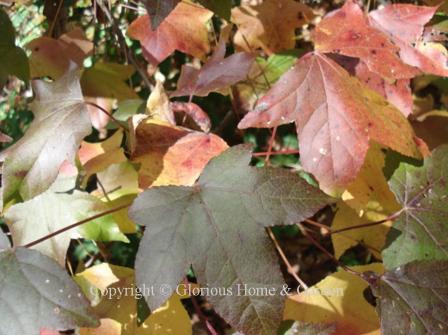 Liquidambar styraciflua
Liquidambar styracifluaLiriodendron tulipifera, tulip poplar, Zones 4-9. One of our most magnificent native trees with tulip-shaped leaves that turn a clear yellow in the fall. They will sometimes begin turning color in late summer or early fall if they have been drought-stressed.
Nyssa sylvatica,
black tupelo, Zones 4-9. Also known as the black gum or pepperidge,
this is one of our best native trees for autumn leaf color. 'Big Momma' is a cultivar with larger leaves and fruit than the species.
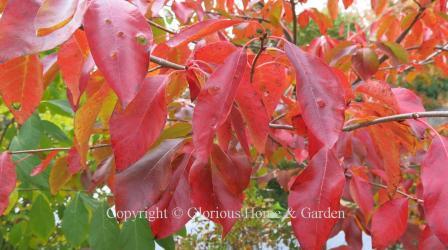 Nyssa sylvatica 'Big Momma'
Nyssa sylvatica 'Big Momma'Oxydendrum arboreum, sourwood, Zones 5-9. Sourwood is one of the first trees to begin turning color in the fall, and one of the longest lasting. Leaves can become pinkish to crimson red to purple.
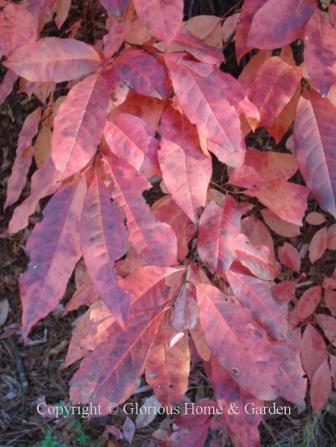 Oxydendrum arboreum
Oxydendrum arboreumPistacia chinensis, Chinese pistache, Zones 6-9. This is an excellent tree for brilliant fall color especially in areas prone to drought such as the south and midwest. Good use was made of them in the parking lot of the Daniel Stowe Botanical Garden in Belmont, N.C.
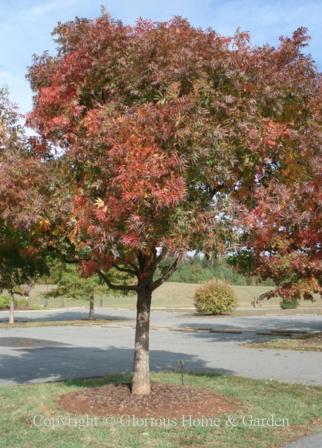 Pistacia chinensis
Pistacia chinensisPrunus x yedoensis, Yoshino cherry, Zones 5-8. Yoshino cherries turn lovely shades of yellow and golden-orange in fall, but the leaves tend to drop early.
Pseudolarix amabilis, golden larch, Zones 5-7. Golden larch is one of that small group of deciduous conifers that includes the dawn redwood (Metasequoia glyptostroboides)and bald cypress (Taxodium distichum). This is a large tree eventually (30-50'), but slow-growing, and turns a beautiful autumn color of golden yellow.
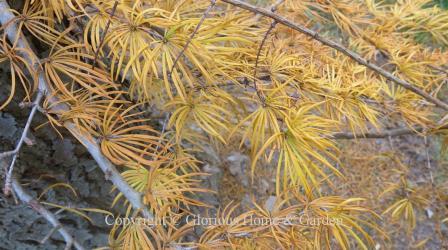 Pseudolarix amabilis
Pseudolarix amabilisPyrus calleryana 'Bradford,' Zones 5-8. Bradford pears may have been overused, and they are subject to splitting and breakage if not properly pruned when young, but they are among the last trees to turn color in the fall (in the South) in deep shades of orange to wine red.
Sassafras albidum, sassafras, Zones 4-9. Easily identified by the mitten-shaped leaves, sassafras is not often planted in the landscape, but should be utilized more for its brilliant autumn leaf color.
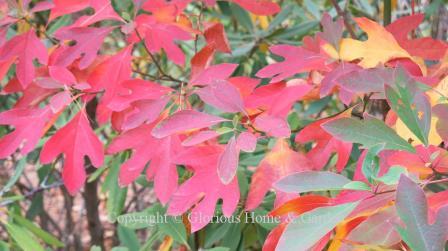 Sassafras albidum
Sassafras albidumStewartia koreana, Korean stewartia, Zones 5-7. Stewartias are lovely garden specimens that often exhibit rich autumn color like this one in the Asticou Azalea Garden in Maine.
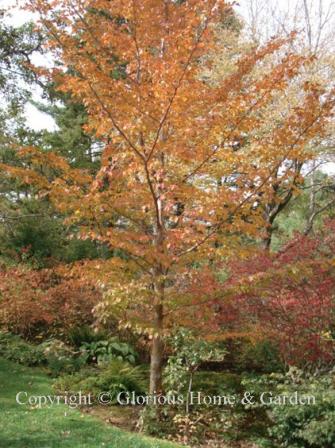 Stewartia koreana
Stewartia koreanaTaxodium distichum, baldcypress, Zones 4-11. Baldcypress is usually thought of as a tree that grows in swampy areas, which it does, but it is also adaptable to drier conditions. As a deciduous conifer, it can be a fine contributor to the autumn landscape turning soft orangey-brown tones as this example at the Lewis Ginter Botanical Garden in Richmond demonstrates.
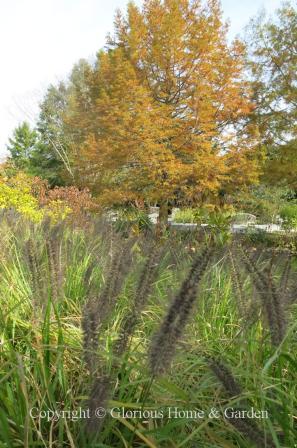 Taxodium distichum
Taxodium distichumUlmus americana, American elm, Zones 3-9. This iconic American native has unfortunately been devastated by Dutch elm disease and other disease and insect pests it is prone to. Once a very common street and landscape tree used for shade, it is not often seen now. Which is unfortunate because it is a beautiful stately tree which can turn a lovely clear yellow in the fall as this picture of a young elm shows. Fortunately, cultivars are being developed for resistance to Dutch elm and other diseases. Some promising cultivars include 'Princeton' and 'Valley Forge.'
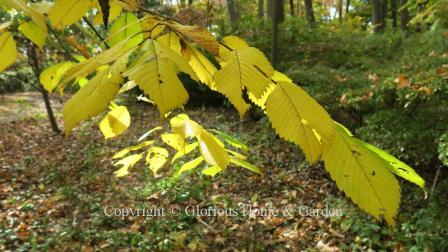 Ulmus americana
Ulmus americanaPlant of the Month
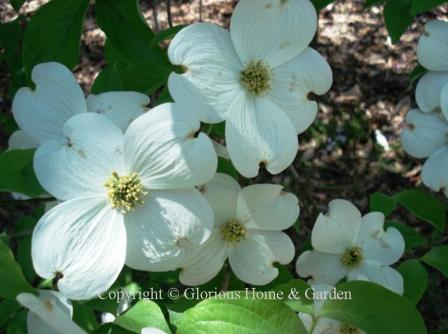
Cornus florida
(Dogwood)
Updated new USDA Plant Hardiness Zone Map 2023.